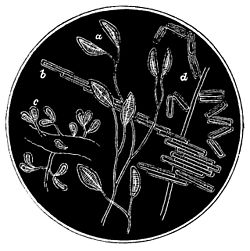he used in the coarser manipulations, but, owing to the presence of chemicals in this room, none of his finer instruments were kept here. He explained his methods of treatment in clearing the soil and dirt from the land specimens, and also showed me the little silk nets which he uses when fishing for the water forms. Certain kinds grow only on the surface of the sea; so, to collect these, it is necessary to go out in a small boat and row very slowly, for the cloth of which the net is made must be very fine in order to prevent the escape of the tiny plants through its meshes. Owing to this extreme closeness of the meshes, the water drains through very slowly. The form of the net is quite like those used to catch butterflies, but is held with the handle up and close to the boat. At very short intervals of time it must be taken up and the water poured out; the inside of the cloth is then carefully rinsed in clear water, which is kept in a jar or bottle for that purpose. The most difficult part of the process is to row slowly and steadily enough to prevent tearing the nets.
These diatoms found on the surface of the water are furnished with long arms or projections, from which protrude hairlike bodies, which apparatus he conjectures is for the following purpose: One means of deciding that this little organism is a plant, is that it performs the function of assimilation, as it is  Fig. 6.—Living Diatoms: a, Cocconema lanceolatum; b, Bacillaria paradoxa; c, Gomphonema marinum; d, Diatoma hyalina. called, by which it gives out oxygen. Now, this gentleman thinks the little hair-like outgrowths are for the purpose of holding the oxygen in their meshes so as to enable the plant to float.
Fig. 6.—Living Diatoms: a, Cocconema lanceolatum; b, Bacillaria paradoxa; c, Gomphonema marinum; d, Diatoma hyalina. called, by which it gives out oxygen. Now, this gentleman thinks the little hair-like outgrowths are for the purpose of holding the oxygen in their meshes so as to enable the plant to float.
After looking through this room and learning as much as possible about his methods of treatment, we went into another much larger and more elegantly furnished apartment, where all the nice and delicate work of studying forms and making models was done. Here were kept the books, all that have been written on this plant, and they filled a case of considerable size; also a very complete collection of microscopical apparatus. All that modern artisans can do in the way of fine and delicate instruments may be found here. Nothing less than the best oil-immersion lenses can be used in the study of form necessary to understand the inner structure of these plants. Several models have been made by this gentleman, and he told me of the
